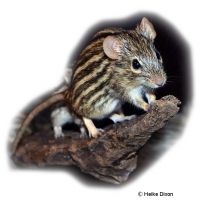Barbary Striped Grass Mouse (Lemniscomys barbarus)
| Barbary Striped Grass Mouse Lemniscomys barbarus | |
|---|---|
| Name | Barbary Striped Grass Mouse |
| Name Lat. | Lemniscomys barbarus |
| Family | Murids |
| Family lat. | Muridae |
| Order | Rodents |
| Order lat. | Rodentia |
| Origin | Africa |
| Climate | Subtropical - tropical |
| Habitat | Steppes, bushland |
| Diet | Seeds, green fodder, insects |
| Behavior | ♂ territorial |
| Keeping | Pair, group |
| Care Level | Moderate |
| Life Span | 3-4 years |
| Protection | No |
| Metric Units | |
| Size | 8-13 cm |
| Temperature | Room temperature |
| Housing | A: 0.5 m² / H: 50-60 cm |
| US Units | |
| Size | 3.1"-5.1" |
| Temperature | Room temperature |
| Housing | 5 ft² / 20" hight |
Distribution and habitat
The range of diurnal and crepuscular many-striped grass mice is Morocco, Algeria and Tunisia, from the Mediterranean coast to the foot of the Atlas Mountains. They live in colonies, inhabiting dry, grassy and scrubby steppes, and establish extensive tunnel systems under the turf.
Maintenance
Minimum dimensions for the enclosure:
| 1-2 animals | area: 0,5 m² | height: 50-60 cm |
| Each additional animal | Area: + 20 |
A terrarium placed in a bright (no direct sunlight), draught-free and quiet place is recommended, with ventilation openings on the sides, and it must not be tightly closed at the top. The enclosure should be structured with stones, roots and branches, and provide hiding and shelter opportunities (rodent houses, platforms, cork tubes, clay caves, hollowed coconuts, etc.). They need food and drinking containers (water bottles), nesting material (hay, grass) and a substrate for digging. Commercially available small animal litter or a peat and sand mixture covered with some bark mulch and dry leaves is suitable as a substrate. The bedding depth should be 10 cm. For the wear of their teeth must always be available nail material, such as untreated twigs and branches of fruit trees, and a rodent stone.
| Temp. day: 22-26 °C | Temp. night: 18-22 °C | Temp. local: 30 °C |
Light sources that also produce the necessary heat are ideal. A natural day-night rhythm must be ensured
Diet
They feed mainly on plants and insects. The species-specific diet consists of a mixture of dwarf hamster and gerbil food available in specialized stores, supplemented with forage hay, fresh food (wild herbs, root vegetables, chicory, zucchini, semi-ripe grass panicles, etc.) and a mineral stone. They need animal protein several times a week, such as insects (crickets, house crickets, mealybug larvae), hard-boiled chicken egg or dry cat food. Pelleted ready-made food is also usually well accepted. Fruit should be offered only rarely and in very small quantities. Drinking water must always be available and, like food, should be offered fresh daily
A varied diet promotes health and prevents deficiency symptoms
Behaviour and compatibility
They are social animals and must be kept at least in pairs, but better in a group of 4-6 animals. A group should consist of one (castrated) male and several females (harem) or only females. There can be fierce territorial fights between unneutered males. At the first sign of incompatibility, separate the animals immediately.
Reproduction and breeding
In the male, the anal and genital openings are farther apart than in the female.
The gestation period is about 21 days. A litter consists of 1-7 young, which are born blind and naked. They develop very quickly, are already independent after about 16 days and are already sexually mature at about 8 weeks. Male young must be separated from the parents before sexual maturity. The life expectancy is 3-4 years.
Important
A sunny place irradiated with a heat lamp (spot) is gladly visited. Their activity phases are followed by rest periods of about the same length (polyphasic)
Variety is provided by changing furnishings and occasional rearrangement. Running wheels must be injury-proof, have a closed running surface and back wall and a diameter of at least 20 cm
As escape animals, they need sufficient retreat and hiding places, so the enclosure should also be somewhat elevated and not placed on the floor
They must not be grabbed or pulled by the tail, as the skin can easily tear and detach. Lighting and heat radiators should be placed in such a way as to prevent injury to the animals. Special attention must be paid to thorough hygiene and contamination must be removed regularly.
Further literature can be found in your pet store.
References
Text: petdata; Image: Heike Dixon
Source: W. PUSCHMANN, D. ZSCHEILE, K. ZSCHEILE (2009): Zootierhaltung - Tiere in menschlicher Obhut: Säugetiere, Harri Deutsch Verlag; EHRLICH (2006): Kleinsäuger im Terrarium, Natur und Tierverlag; BMEL (2014): Gutachten über Mindestanforderungen an die Haltung von Säugetieren
- Gemäß § 21 Abs. 5 Tierschutzgesetz idgF
